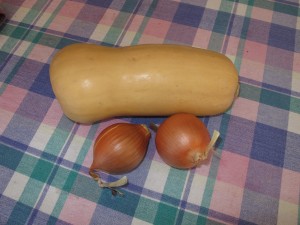A Winter Meal from the Garden
Technically, spring arrived on March 20. Most years I have snowdrops blooming on a south-facing hillside by early March, and some Glory-of-the-Snow in blossom by now. Not this year. Snow is still deep on my property, and nights with temperatures near zero have been common. Sigh. But I have a few plants started by seed growing under lights, to keep me chipper.
I also continue to eat from my garden. Yes, all those frozen and stored veggies keep me well fed and looking forward to this year’s vegetable garden. One of the best vegetables I grow is the butternut squash, specifically one called ‘Waltham’. It stores well in a cool, dry spot and is full of vitamins and energy. I recently made a butternut and apple soup with one, and it was fabulous. I got the idea from Anne Yates of Anne’s Country Store in Plainfield, NH, which has a great deli. She told me what she did (without any measurements), and I created my own version of it while also trying to use just home-grown veggies.
Usually I steam squash to cook it, but Anne said she roasted hers, so I tried that approach. I cut a large butternut in half lengthwise, cleaned out the seeds and lightly oiled the cut surface. I placed it face down on a cookie sheet and roasted at 350 degrees for an hour or more. This caramelized the sugars and made the squash even sweeter than it was. I scooped out the meat from the skin; it yielded about 3 cups of meat.
From my freezer I took out a jug of frozen apple cider. I bring apples to my local orchard in the fall, and have them press my apples (for a price) and put the cider in plastic half gallon jugs, which I freeze. I added cider (a quart in total) to the squash meat in my food processor and pureed it in a few batches.
Although I do grow fresh ginger in pots, and have some I could have harvested, I had some grocery store ginger that I peeled and chopped for this soup. I prepared a quarter cup of chopped ginger, which I then sautéed with 2 cups of chopped onions at low heat until the onions were clear and somewhat caramelized. After cooking the onions and ginger, I blended them in the processor, and added it to the squash and cider which was simmering on low heat.
Next, I cleaned up the last of my carrots from the garden that were starting to look wrinkly and bedraggled in my vegetable drawer. I had about 2 cups of carrots, so that is what I used. Of those, some I added to the soup as rounds, some I blended briefly in the processor. I added a cup of chicken broth at this time, though vegetarians could omit this.
Last fall was great for apples, so I froze lots of sliced apples. For this soup I used 4 cups of frozen apple slices with the skins on. I cooked them with a little water in a saucepan until soft, and then blended them into an applesauce-like mixture in the food processor. That produced about 2 cups of applesauce – which you could substitute here if you didn’t have fresh or frozen apples.
After I added the applesauce to the soup, I added a light sprinkle of nutmeg and some salt and pepper. And no, I don’t produce or collect the nutmeg, salt or pepper. There is just so much one can do to eat locally.
When it comes to growing butternut squash, I like to start seeds in the house a month before it is time to put them in the garden. I say a month because conventional wisdom is that squash family plants (including cukes, pumpkins, and melons) don’t like to have their roots disturbed. An 8-week old squash plant has a big root system and might be stunted or slowed in growth when transplanted into the garden. I plant in June after the soil is plenty warm.
The main reason I start squash indoors instead of planting seeds directly in the garden is this: there is a terrible insect pest, the striped cucumber beetle, that loves the tender first leaves of any squash-family plant. They are active at night, and will eat off the first 2 leaves of a young plant, killing it. But a 4-week old plant will have enough leaves to survive being chewed on by a few beetles.
You can also cover your seedlings with something called row cover or Reemay. It is a breathable fabric that physically keeps the beetles off the seedlings – unless they come up under it (they live in the soil). But I remove the row cover when the vines blossom – they need insects for pollination.
So try making this soup. The ginger gives it quite a kick, but next time I might add some of the hot pepper powder I make each year. And think about growing Waltham butternuts. They take some garden space (I allocate a 5-by 5-ft space for 3 plants) but are very productive – and tasty, too!
Henry’s Web site is www.Gardening-Guy.com. He is the author of 4 gardening books and a children’s fantasy-adventure about a boy with a mustache and his sidekick, a cougar.



